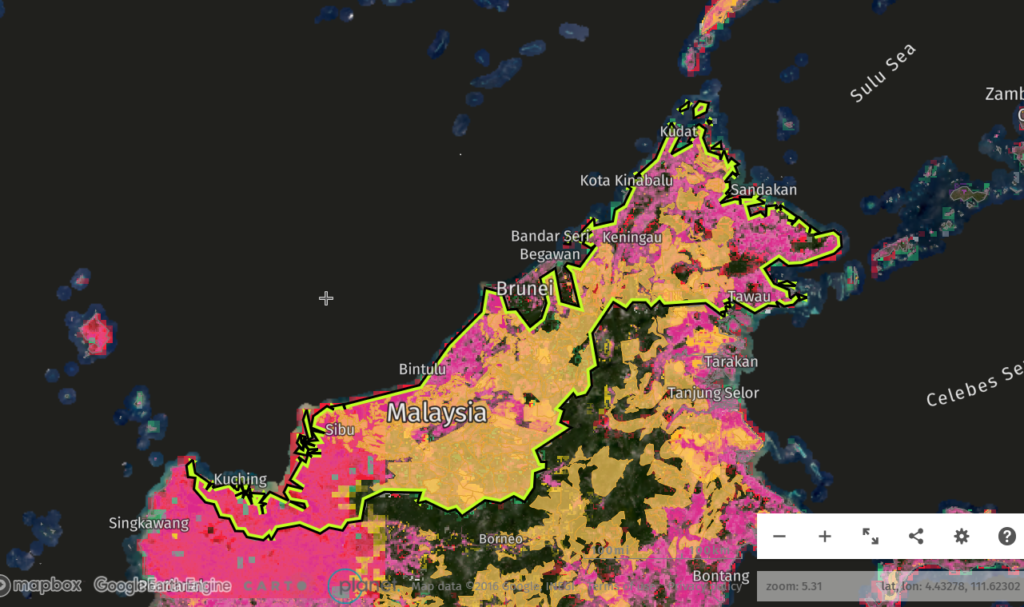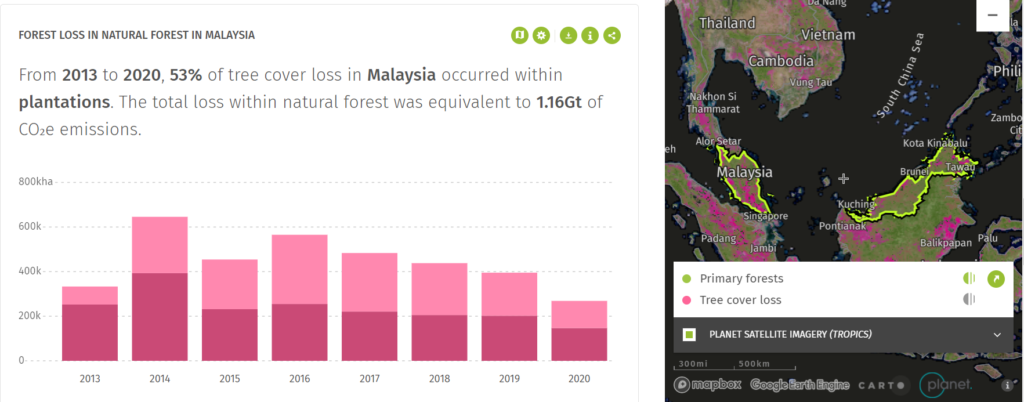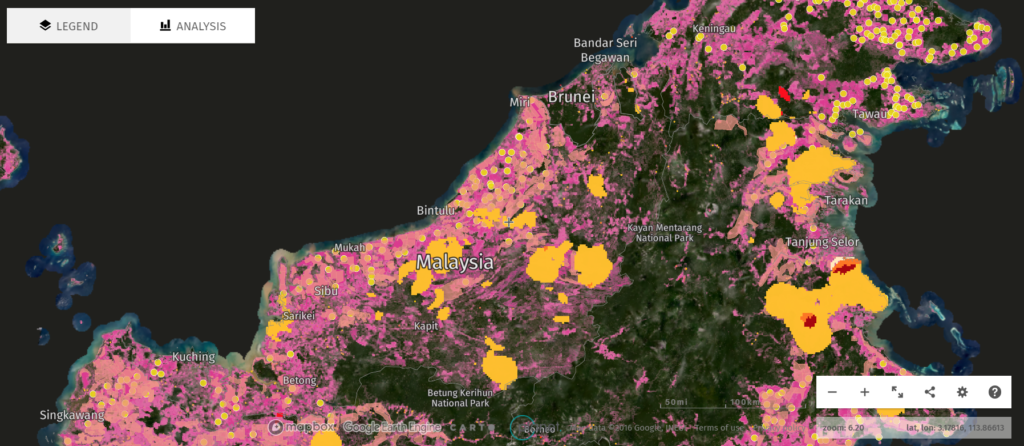
KUALA LUMPUR, Dec 2 –The map of Sarawak as seen through the latest Global Forest Watch (GFW) indicates that the state’s economy will continue to revolve around the exploitation of its natural resources, with new and more allocations of concessions for logging, oil palm cultivation and wood fibre. Half of the state is covered by concessions of one or other. This is not new. Just the story of Sarawak’s deforestation over the decades and how it may need an urgent retelling.
Malaysia’s pledge to bring down carbon emissions to net zero by 2050 at the COP 26 should be a catalyst for a change in how Sarawak views its forests: Will it be a national heritage? Will more be done to retain this expansive natural carbon sink, a barrier against climate change in the state, region?
Or will it be a perennial goldmine for more enrichment of a few and degradation of too many including its native people, wildlife, environment, mega biodiversity and ecosystems?
Despite the various efforts taken by the Forest Department of Sarawak towards sustainable forest management of 3.9 million hectares of permanent forest estates, including plans for long term forest timber licence (FTL) to be certified by 2022, it may not be enough considering that forest business activities do remove forests and replanting new trees will not undo damages to ecosystems and wildlife habitat.


While calls continue to be made for transition into new, green and sustainable economic activities to ease on the deforestation of Sarawak, the state continues to rely on its forests for revenue and logging licenses and concessions continue.
From the year 2000 to January 2021, the state received a total of RM13,705,765,876 from royalties, premiums, tariff and other payments with an average annual revenue of RM685 million from logging alone in swamp areas, hills and planted forest.
Oil palm and forest wood are other major revenue earners from Sarawak land.
According to data from GFW, Sarawak had 9.57 million hectares of natural forest, extending over 91 percent of its land in 2010. By 2020, it had lost over 56,000 hectares of natural forest, equivalent to 39.2 million tonnes of carbon dioxide or CO2 of emissions.
From 2002 to 2020, the state lost 1.60 million hectares of humid primary forest, making up 55 percent of its total tree cover loss. For the same period, Sarawak lost 2.93 million hectares of tree cover, equivalent to a 25 percent decrease in tree cover since 2000, and 2.28Gt of CO2 emissions.
Satellite images as recent as late October to November this year, showed active new hot spots of deforestation in the state. There were reports of fires in some of these spots although this could not be confirmed locally.
While economic development, infrastructures, opening of industrial areas, jobs for the locals are cited for the state’s continued opening of its forest areas, the beneficiaries are also mostly large corporations that employ foreigners to carry out work in the plantations and factories.
The industry players and license holders of timber and palm oil have raked in billions of dollars through the export and local marketing of the forest materials, commodities and products.
Against such a backdrop, the listing of Sarawak as the third poorest state in the country is quite an irony considering the billions in revenue earned by the state not just from timber but oil palm and other forest products as well as its oil and gas.
Many indigenous people of the state are still mired in poverty. Climate change is expected to further exacerbate their living conditions.
In the 2022 Malaysian Budget, the Federal government has allocated RM4 billion while the state government has allocated RM7 billion to uplift the state. A huge portion of this is expected to go into development. The details are not there yet.
A 2020 report, “Emerging challenges for sustainable development and forest conservation in Sarawak, Borneo”, authored by Mohammed Alamgir,Mason J. Campbell, Sean Sloan, Jayden Engert, Jettie Word, William F. Laurance and edited by Puneet Dwivedi, University of Georgia, US, outlined the importance of the forest of Borneo.
They called it one of the last remaining tropical forest strongholds on the planet and suggested that in the long run the value of retaining the trees and their carbon storage will outdo the short-term gains seen from deforestation.
“Agriculture expansion, industrial-scale logging, oil-palm plantations, illegal hunting, and the expansion of roads and other infrastructure, such as hydroelectric dams have been attributed to the persistent loss of forest and biodiversity in Borneo.”
According to the report, the Bornea island, which includes Sarawak, harbours 37 million hectares of biodiversity-rich tropical forests as well as extensive carbon-rich peatlands. Borneo has lost more than 18 million hectares of forest since 1973. Consequently, more than 600 vertebrate and plant species are threatened with extinction risk in the region.


A local environmentalist said that while it was too late for some parts, it is not too late for a critical shift in how the forests are valued.
“What is needed is a shift. Sarawak is a big state, with its forests storing huge amounts of carbon, and critical thinking and planning must revolve around this,” he said.
While the Sarawak Forestry Corporation is known for its professional enforcement activities and protection of areas it has been entrusted with, the land given for logging and other activities that result in the emission of greenhouse gases, remain beyond their jurisdiction, the environmentalist told Weekly Echo.
Logging licenses and concessions are issued by the Forestry Department. In other parts of Malaysia the forestry departments in general are responsible for the maintenance and sustenance of the natural environment of forest, but in Sarawak, the department works along a different route as it has a unique role of managing the forest business of the state.
“Of course all these are done under sustainable practices and so on. But how sustainably the forest industry participants are operating, can only be answered by the concession owners,” he said.
There are talks of initiatives including green industries to reduce carbon emission, but these are still new and have scant allocations compared with the thousands of hectares of land already being operated under the hands of established players including the state.
Meanwhile, naturalist and CEO of Ecotourism & Conservation Society Malaysia (ECOMY), Andrew Sebastian said the recent announcement by Prime Minister Datuk Seri Ismail Sabri Yaakob that the government is considering compensating states that preserve their forests was commendable.
“This has been long advocated by environmental groups worldwide for federal governments to compensate or protect their country’s natural forests by all means. Most federal governments do not have control over state lands.”
This will help if states have not already “sneaked into degazetting forest areas for agricultural purposes.”
He also said that environmental groups were not against the business of plantations but these plantations should not be replacing natural forests as they will damage the tree cover, natural ecosystems, wildlife, river reserves and water catchment areas among others.
These plantations can be started elsewhere.
With the state election around the corner, a manifesto that includes strategies for forest management against the threats of climate change could be a game changer, he added.
–WE